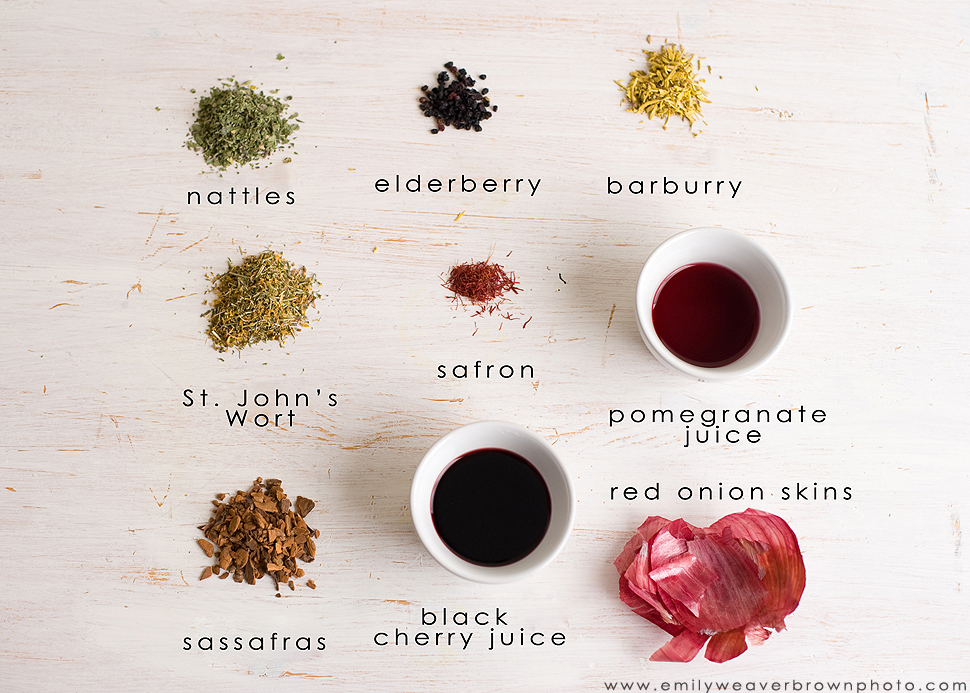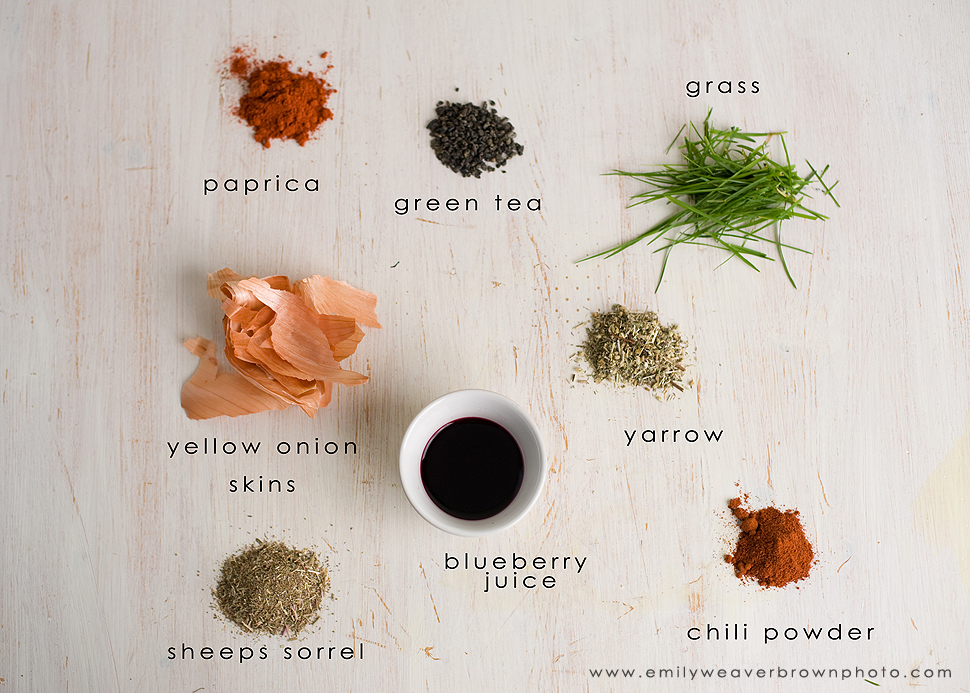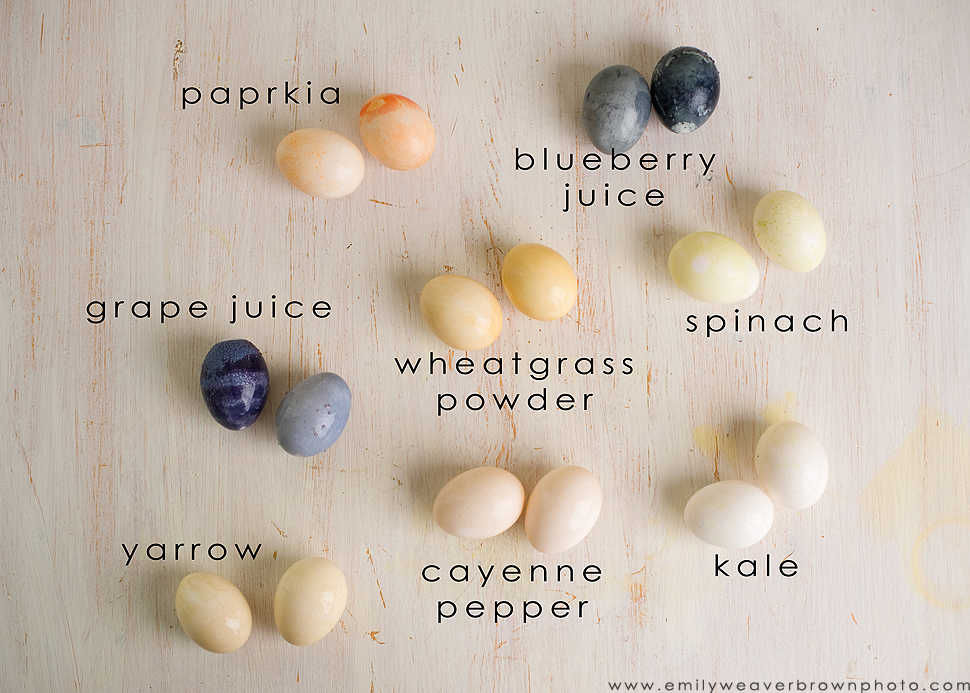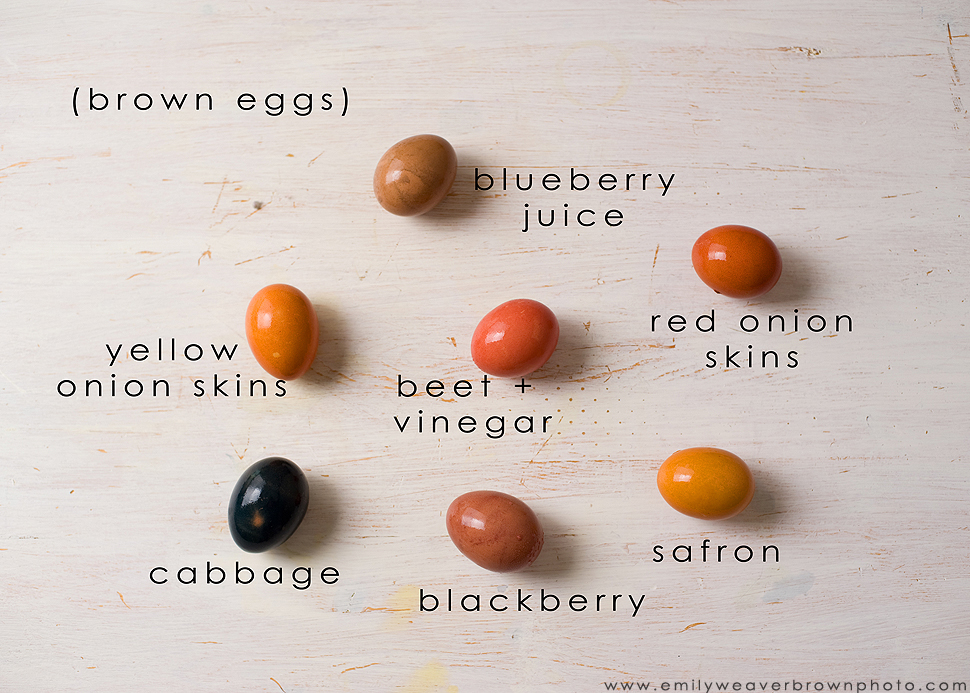This is the third year that I have attempted to make my own egg dyes from natural substances. (You can see year one and two here) This year I really wanted to focus on making bold colors and in the process I have learned a lot about ancient dying techniques. I spent some time researching plants that were historically used to dye fabric and cross checking them to make sure they were not poisons (many are!) what I learned is that dye is largely effected by the PH of the dye bath and the mineral content of the water. How well an egg shell takes dye can also be effected by how it was handled and washed – according to the USDA website egg shells are washed and sanitized at a processing plant before they ever reach the store shelf. I don’t know what exactly they use to wash and sanitize the eggs but I would venture to guess that whatever detergent is used that it raises the PH of the eggshell. All this to say that some of the dye substances (pomegranate, cabbage, beet ) which contain naturally occurring anthocyanins, are very PH sensitive (I blogged about this at Christmas when we decorated cookies with natural dyes) You can thus control the color outcome of the dye solution by raising or lowering the PH using vinegar and baking soda. You will notice the beet without vinegar is brown but the beet with vinegar is pink.
Enough about the science, here are the photos. This year I tested 34 different dye substances. For the most part I use a strong tea method for dying eggs. Meaning I boil the dye substance in water then add the eggs to tea and allow them to sit in the dye water (in the refrigerator) overnight. The exception would be the fresh green plants (grass, kale, spinach), which I just combined with water in our vitamix blender until I had a liquid, I thought that boiling them would turn them brown. However, as you will see I was unsuccessful with coming up with a bold green dye so next year I plan to trying the boiling method.
So here are they dye substances:
And here are the resulting colored eggs:
and then I tried some of what I consider the more successful dyes on brown eggs just to see what color variation I would get with them…
In the first images in this blog post I strengthened the cabbage dye by boiling it down further and making it more concentrated. Concentrating the dye like that works well for most of the colors but letting them sit overnight is imperative for getting bold colors.
I tried every substance that I could get my hands on and that was mentioned as a possible dye (that was not poisonous). Overall I was pretty happy with the egg colors my only disappointment is that I was not able to achieve a bold green color. I have some more ideas for this which I will implement next year. I don’t think that transferring chlorophyll to an egg shell will be successful on the spinach left a faint green tint on the egg but I will try those dye substances again but also adding vinegar and or salt to see if that helps them stick to the egg better. Nettles were really the only green dye that I considered successful as it made a faint green. I did also try taking some eggs dyed in saffron (bright yellow) and then dipping them in cabbage (bright blue) if you remove the egg from the blue dye after a few minuets you get a pale green but if you leave it too long the blue just over powers the yellow. My other idea for green is to REALLY lower the PH on the cabbage dye bath. If you get the cabbage water PH low enough it does turn green so that might work for dying an egg green – worth a try anyway. I will say that I am rather suspicious of some of the articles and blog post that I have read on coloring eggs naturally many of them show images of brightly colored eggs but then do little to explain how they got to the intense color or when I try their method I only get a pale color or a different shade entirely. So there you have it! If you have any other ideas on dye substances or methods for achieving green please do leave a comment. As always you are more than welcome to link to this blog post but please do not take my images without my permission (I like to share, all you have to do is ask!). Happy Easter!
My Portfolio | Contact Me | Follow Me @emilyWbrown
Portfolio | Contact Me | Book a Session .
.













These are beautiful! I love how “natural” they look even with dye on them. I need to get brave and try this!
This is fantastic! I wrote a post about using natural ingredients to dye eggs – and am going to add a link to your post inside of mine. (Yours is way better!!)
You probably know this already, but onion skins are the traditional source of dye for Easter eggs in Russia – my host mom made them that way when I was there. 🙂
Love this post! You really got some beautiful colors.
WOW! Beautiful results. I love that you used white and brown eggs.
Amazing, Emily! Thanks for all of your hard work. I love love love the onion skins color. Do you think the color is so bold due to onions being acidic?
Wow you’re so scientific. I’m impressed! This year I found India Tree Natural Decorating Colors at my health food store. I experimented with them at St Patricks day and it was nearly impossible to get a good green! Yellowish or brownish, but nothing pretty. The other colors are good though, they use red cabbage, beet juice with citric acid, and curcumin. I am going to experiment with these for Easter. Thanks for the info!
What if you did multiple dyebaths of the green to build the color?
What a great guide! I had a lot of fun doing natural dyes this year too. I was able to achieve green by doing a long soak in turmeric dye and a rather short soak in cabbage dye: http://www.facebook.com/photo.php?fbid=10150166757809235&set=a.10150166757754235.310133.619074234&type=3
What a lot of work you have done testing different dye materials. I have been using natural dyes for a number of years. The dyes that work the best are the red and yellow onion skins, red cabbage, turmeic, coffee or tea. Like Alisha I use the red cabbage dye and then the tumeric to get a pretty green. You can go from the tumeric to the cabbage too, both work with different variations. Something I do is save the skins from the onions and the leaves from the cabbage when I make the dyes. I put the skins or leaves in a plastic container, then I take a egg and wrap it in the material and tuck it down in the container making sure there is a bit of the dye in the bottom. Leave this set for a hour or longer, even overnight. You will get great marbling and patterns. You can put the egg in dye again if you wish, a blue marbled egg in tumeric dye.
I blow out all of my eggs, I also spay the finished eggs with a clear Krylon spray as the natural dyes fade otherwise. Last year I did 10 dozen eggs. Here is a link to my Pinterest board with my eggs. http://pinterest.com/katieann323/my-special-things/
I will be checking back to see what you came up with this year.
I used to dye yarn the old fashioned way and the material that the pot to boil the materials in would often affect the colours. So boiling the stuff in an iron pot would produce one colour, boiling it in a tin or copper pot would produce a different colour. This made a huge difference for the plants used to get green (tansy, goldenrod, etc) which would be green done one way, and yellow done another. I think it was the iron pot that enhanced the green, but don’t quote me on that!
thanks I will try a cast iron pot next year.
What a great post. Such beautiful work you went through to compile all of this. I wish I had found your article before dying our eggs on Monday. It was a fun experiment though. I’m bookmarking your page.
http://colourmehappy.typepad.com/colour-me-happy/2012/04/diy-natural-dye-easter-eggs.html
I was recommended this web site by my cousin. I am no longer positive whether this publish is written via him as no one else know such special about my trouble. You’re wonderful! Thanks!